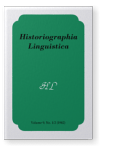Vol. 9:1/2 (1982) ► pp.107–120
Philosophical Motives in Wilhelm von Humboldt’s Defense of the Inflectional Superiority Thesis
Wilhelm von Humboldt, like many other linguists in the early 19th century, claimed that inflectional languages are superior to non-inflecting languages. This thesis waned in popularity after the middle of the century, and the reasons why the claim was made have become historically obscured. The tendency in many modern accounts is to view the inflectional superiority thesis (IST) as a cultural or literary prejudice typical of the nationalism and romanticism of Humboldt’s period (Sapir 1921, Hönigswald 1937). Against this account I argue that, in Humboldt’s case at least, the IST followed consistently from two philosophical assumptions that were axiomatic in his philosophy of language. (A) Humboldt distinguished between the conceptual constituents of thoughts (Gedankeneinheiten) and their grammatical inter-relationships. The former are the units of ‘meaning’, the latter only modifications of the former and thus in themselves ‘meaningless’ (bedeutungslos). (В) Grammatical relations, further, never stand alone in a thought but are always ‘attached’ to concepts. Operating with (A) and (B) Humboldt argued that the ideal symbolic (linguistic) representation of thought will indicate grammatical relations by affixes which are (A) meaningless in their own right, having no meaning beyond their grammatical significance, and (B) are always attached or ‘fused’ to the radical words being grammatically modified. Highly inflectional languages come closest to this ideal. They represent thought in a more isomorphic fashion than languages using other grammatical methods. Thus the IST, in Humboldt’s version, is a semiotic claim. As such it should be understood as a result not of nationalism or Indo-European cultural prejudice but rather of Enlightenment philosophy and psychology.
References
Cited by
Cited by 1 other publications
This list is based on CrossRef data as of 3 july 2024. Please note that it may not be complete. Sources presented here have been supplied by the respective publishers. Any errors therein should be reported to them.
